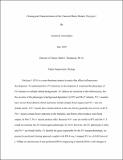Cloning and Characterization of the Classical Maize Mutant, Polytypic1
Author
Amoiroglou, Anastasia
Abstract
Polytypic1 (Pt1) is a semi-dominant mutant in maize that affects inflorescence development. To understand how Pt1 functions in development, I examined the phenotype of Pt1 mutants in multiple inbred backgrounds. Pt1 defects are restricted to the inflorescence, but the severity of the phenotype is background dependent. In B73 and Mo17 inbreds, Pt1/+ mutants have severe floral defects; floral meristems initiate ectopic floral organs and Pt1/+ ears are female sterile. Pt1/+ tassels have similar defects as the ear, but are generally less severe. In B73, Pt1/+ tassels contain fewer spikelets on the branches, and florets often produce extra floral organs. In Mo17, Pt1/+ tassels produce silks. Because Pt1/+ ears are sterile in B73 and Mo17, I could not examine the Pt1 homozygous phenotype. In A619, however, the Pt1 phenotype is mild and Pt1/+ are female fertile. To identify the gene responsible for the Pt1 mutant phenotype, we pursued a positional cloning approach coupled with RNA-seq. I mapped Pt1 to a 6.8cM interval (~5Mbp) on chromosome 6 and performed RNA-sequencing to identify RNAs with changes in expression levels or sequence. The Pt1-containing interval contains 111 genes that are expressed in ear primordia, nine of which are differentially expressed. Notably, 13 MADs-box transcription factors, which are known floral regulators, are dramatically downregulated in Pt1 mutants. The characterization of Pt1 mutants will give insight into the mechanisms that underlie normal inflorescence development.
Subject
Date
2019-07-15
Citation:
APA:
Amoiroglou, Anastasia.
(July 2019).
Cloning and Characterization of the Classical Maize Mutant, Polytypic1
(Master's Thesis, East Carolina University). Retrieved from the Scholarship.
(http://hdl.handle.net/10342/7470.)
MLA:
Amoiroglou, Anastasia.
Cloning and Characterization of the Classical Maize Mutant, Polytypic1.
Master's Thesis. East Carolina University,
July 2019. The Scholarship.
http://hdl.handle.net/10342/7470.
June 29, 2024.
Chicago:
Amoiroglou, Anastasia,
“Cloning and Characterization of the Classical Maize Mutant, Polytypic1”
(Master's Thesis., East Carolina University,
July 2019).
AMA:
Amoiroglou, Anastasia.
Cloning and Characterization of the Classical Maize Mutant, Polytypic1
[Master's Thesis]. Greenville, NC: East Carolina University;
July 2019.
Collections
Publisher
East Carolina University

